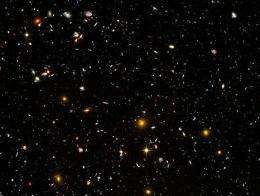October 2, 2013 weblog
Physics duo suggest using early universe inflation as graviton detector

(Phys.org) —Physicists Lawrence Krauss and Frank Wilczek of Arizona State University and Australian National University, respectively, have uploaded a paper to the preprint server arXiv, in which they propose that it might be possible to establish the quantization of gravity by measuring the polarization of the Cosmic Microwave Background (CMB). Doing so they suggest, would provide a link between it and gravitational waves caused by inflation in the early universe.
Physicists, as most are aware, have been stymied in their efforts to discover a way to unify quantum mechanics and gravity—most scientists in the field believe there is likely a gravity particle—they call it a graviton—that carries the force known as gravity. No one of course has ever seen one, or been able to prove it exists. This is because, they say, of how weak it is compared to the other forces, such as electromagnetism—to be able to see it, some have suggested, would require a device so massive that it would collapse in on itself into a black hole. For this reason, some researchers have suggested that we will never be able to see it. In their paper, Krauss and WIlczek suggest that it might not be necessary to see it, because there might be a way to infer its existence by measuring the CMB.
Their idea is that in the early universe, just after the Big Bang, as inflation was occurring—gravitational waves should have been created which in turn would have caused photons present in the CMB to scatter in a certain pattern. Finding that pattern, they continue, would mean finding evidence of a particle that was carrying the gravitational force—the graviton. And if evidence for the existence of a graviton could be found, then physicists would finally have their universal theory. They add that they believe that dimensional analysis could provide a link between those early gravitational waves and Planck's constant, which is of course used in quantum mechanics.
There are a couple of issues with the new theory—the first is that technology does not yet exist to measure the CMB in a way that would allow scientists to detect those early gravitational waves. Another is proving that any polarization found in the CMB can indeed be attributable to gravitational waves and not some other mechanism, force or process.
More information: Using Cosmology to Establish the Quantization of Gravity, arXiv:1309.5343 [hep-th] arxiv.org/abs/1309.5343
Abstract
While many aspects of general relativity have been tested, and general principles of quantum dynamics demand its quantization, there is no direct evidence for that. It has been argued that development of detectors sensitive to individual gravitons is unlikely, and perhaps impossible. We argue here, however, that measurement of polarization of the Cosmic Microwave Background due to a long wavelength stochastic background of gravitational waves from Inflation in the Early Universe would firmly establish the quantization of gravity.
Journal information: arXiv
© 2013 Phys.org



















